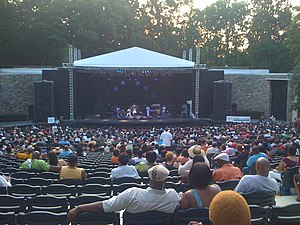로그 슈뢰딩거 방정식
Logarithmic Schrödinger equation이론 물리학에서 로그 슈뢰딩거 방정식(LNSE 또는 LogSE라고도 함)은 슈뢰딩거 방정식의 비선형 수정 중 하나이다.응용 프로그램과 양자 mechanics,[1][2][3]양자 optics,[4]핵 physics,[5][6]교통과 확산 phenomena,[7][8] 열린 양자 시스템과 정보의 확장에 대해 그것은 고전 파동 방정식 theory,[9][10][11][12][13][14]효과적인 양자 중력과 물리적 진공 models[15][16][17][18]과 초유 동성과 보의 이론이다.se–Einstein이다.[19][20]그것의 상대론적 버전은 (라플라시안과 1차 시간 도함수 대신 달랑베르티안을 사용한) 제럴드 [21]로젠에 의해 처음 제안되었다.이것은 통합 가능한 모델의 예입니다.
방정식
로그 슈뢰딩거 방정식은 편미분 방정식이다.수학과 수리 물리학에서는 종종 무차원 형식을 사용합니다.
복소수 함수 θ = 시간 t에서의 입자 위치 벡터x = (x, y, z)의 θ(x, t) 및
는 데카르트 좌표에서 θ의 라플라시안이다.로그 용어 ln 2 \ln \는 매우 낮은 [22]온도에서 헬륨-4의 압력 입방근으로서 음계의 속도를 결정하는 데 필수적인 것으로 나타났다.로그 용어에도 불구하고 중심 전위의 경우, 0이 아닌 각운동량에서도 LogSE는 선형상대방식에서 발견된 것과 유사한 특정 대칭을 유지하므로 원자 [23]및 핵 시스템에 잠재적으로 적용할 수 있다.
이 방정식의 상대론적 버전은 클라인-고든 방정식과 유사하게 달랑베르티안으로 미분 연산자를 대체함으로써 얻을 수 있다.가우손으로 알려진 솔리톤 유사 용액은 많은 경우 이 방정식의 분석적 해법으로 두드러진다.
「 」를 참조해 주세요.
레퍼런스
- ^ Bialynicki-Birula, Iwo; Mycielski, Jerzy (1976). "Nonlinear wave mechanics". Annals of Physics. 100 (1–2): 62–93. doi:10.1016/0003-4916(76)90057-9. ISSN 0003-4916.
- ^ Białynicki-Birula, Iwo; Mycielski, Jerzy (1975). "Uncertainty relations for information entropy in wave mechanics". Communications in Mathematical Physics. 44 (2): 129–132. Bibcode:1975CMaPh..44..129B. doi:10.1007/BF01608825. ISSN 0010-3616.
- ^ Bialynicki-Birula, Iwo; Mycielski, Jerzy (1979). "Gaussons: Solitons of the Logarithmic Schrödinger Equation". Physica Scripta. 20 (3–4): 539–544. Bibcode:1979PhyS...20..539B. doi:10.1088/0031-8949/20/3-4/033. ISSN 0031-8949.
- ^ Buljan, H.; Šiber, A.; Soljačić, M.; Schwartz, T.; Segev, M.; Christodoulides, D. N. (2003). "Incoherent white light solitons in logarithmically saturable noninstantaneous nonlinear media". Physical Review E. 68 (3). doi:10.1103/PhysRevE.68.036607. ISSN 1063-651X.
- ^ Hefter, Ernst F. (1985). "Application of the nonlinear Schrödinger equation with a logarithmic inhomogeneous term to nuclear physics". Physical Review A. 32 (2): 1201–1204. doi:10.1103/PhysRevA.32.1201. ISSN 0556-2791. PMID 9896178.
- ^ Kartavenko, V. G.; Gridnev, K. A.; Greiner, W. (1998). "Nonlinear Effects in Nuclear Cluster Problem". International Journal of Modern Physics E. 07 (2): 287–299. arXiv:nucl-th/9907015. doi:10.1142/S0218301398000129. ISSN 0218-3013.
- ^ Martino, S. De; Falanga, M; Godano, C; Lauro, G (2003). "Logarithmic Schrödinger-like equation as a model for magma transport". Europhysics Letters (EPL). 63 (3): 472–475. doi:10.1209/epl/i2003-00547-6. ISSN 0295-5075.
- ^ Hansson, T.; Anderson, D.; Lisak, M. (2009). "Propagation of partially coherent solitons in saturable logarithmic media: A comparative analysis". Physical Review A. 80 (3). doi:10.1103/PhysRevA.80.033819. ISSN 1050-2947.
- ^ Yasue, Kunio (1978). "Quantum mechanics of nonconservative systems". Annals of Physics. 114 (1–2): 479–496. doi:10.1016/0003-4916(78)90279-8. ISSN 0003-4916.
- ^ Lemos, Nivaldo A. (1980). "Dissipative forces and the algebra of operators in stochastic quantum mechanics". Physics Letters A. 78 (3): 239–241. doi:10.1016/0375-9601(80)90080-8. ISSN 0375-9601.
- ^ Brasher, James D. (1991). "Nonlinear wave mechanics, information theory, and thermodynamics". International Journal of Theoretical Physics. 30 (7): 979–984. doi:10.1007/BF00673990. ISSN 0020-7748.
- ^ Schuch, Dieter (1997). "Nonunitary connection between explicitly time-dependent and nonlinear approaches for the description of dissipative quantum systems". Physical Review A. 55 (2): 935–940. doi:10.1103/PhysRevA.55.935. ISSN 1050-2947.
- ^ M. P. 데이비드슨, 누오브CIM. B116 (2001) 1291.
- ^ López, José L. (2004). "Nonlinear Ginzburg-Landau-type approach to quantum dissipation". Physical Review E. 69 (2). doi:10.1103/PhysRevE.69.026110. ISSN 1539-3755.
- ^ Zloshchastiev, K. G. (2010). "Logarithmic nonlinearity in theories of quantum gravity: Origin of time and observational consequences". Gravitation and Cosmology. 16 (4): 288–297. arXiv:0906.4282. doi:10.1134/S0202289310040067. ISSN 0202-2893.
- ^ Zloshchastiev, Konstantin G. (2011). "Vacuum Cherenkov effect in logarithmic nonlinear quantum theory". Physics Letters A. 375 (24): 2305–2308. arXiv:1003.0657. Bibcode:2011PhLA..375.2305Z. doi:10.1016/j.physleta.2011.05.012. ISSN 0375-9601.
- ^ Zloshchastiev, K.G. (2011). "Spontaneous symmetry breaking and mass generation as built-in phenomena in logarithmic nonlinear quantum theory". Acta Physica Polonica B. 42 (2): 261–292. arXiv:0912.4139. Bibcode:2011AcPPB..42..261Z. doi:10.5506/APhysPolB.42.261. ISSN 0587-4254.
- ^ Scott, T.C.; Zhang, Xiangdong; Mann, Robert; Fee, G.J. (2016). "Canonical reduction for dilatonic gravity in 3 + 1 dimensions". Physical Review D. 93 (8): 084017. arXiv:1605.03431. Bibcode:2016PhRvD..93h4017S. doi:10.1103/PhysRevD.93.084017.
- ^ Avdeenkov, Alexander V; Zloshchastiev, Konstantin G (2011). "Quantum Bose liquids with logarithmic nonlinearity: self-sustainability and emergence of spatial extent". Journal of Physics B: Atomic, Molecular and Optical Physics. 44 (19): 195303. arXiv:1108.0847. Bibcode:2011JPhB...44s5303A. doi:10.1088/0953-4075/44/19/195303. ISSN 0953-4075.
- ^ Zloshchastiev, Konstantin G. (2019). "Temperature-driven dynamics of quantum liquids: Logarithmic nonlinearity, phase structure and rising force". Int. J. Mod. Phys. B. 33 (17): 1950184. arXiv:2001.04688. doi:10.1142/S0217979219501844.
- ^ Rosen, Gerald (1969). "Dilatation Covariance and Exact Solutions in Local Relativistic Field Theories". Physical Review. 183 (5): 1186–1188. doi:10.1103/PhysRev.183.1186. ISSN 0031-899X.
- ^ Scott, T. C.; Zloshchastiev, K. G. (2019). "Resolving the puzzle of sound propagation in liquid helium at low temperatures". Low Temperature Physics. 45 (12): 1231–1236. arXiv:2006.08981. doi:10.1063/10.0000200.
- ^ Shertzer, J.; Scott, T.C. (2020). "Solution of the 3D logarithmic Schrödinger equation with a central potential,". J. Phys. Commun. 4 (6): 065004. doi:10.1088/2399-6528/ab941d.


 매우 낮은
매우 낮은 

